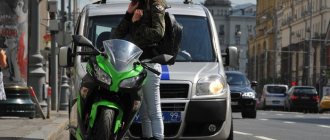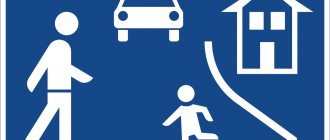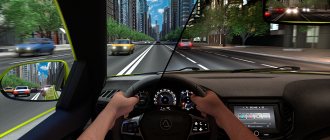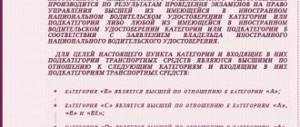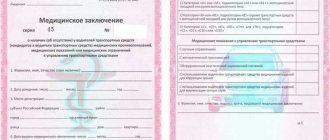Who is a pedestrian?
A pedestrian is a road user who, when moving, does not drive a vehicle or perform work on it. Pedestrians include disabled people in wheelchairs without a mechanical motor, owners of bicycles or mopeds who move them along the road.
In a word, a pedestrian is a person who walks on the roadway. According to the law, he is allowed to move on pedestrian paths, sidewalks or on the side of the road towards vehicle traffic if the first two options are not available.
Why (electric) scooters are pedestrians and how to fix it
With the onset of warm weather, active discussions of electric scooters began again - should they ride on sidewalks or on bicycle paths, and given that there are very few of the latter in Russia, then maybe on the roadway?
It must be admitted that there are so many electric scooters that they really begin to interfere with pedestrians, while their speed (and therefore potential energy) is such that in a collision with a pedestrian it poses a threat to the latter’s health, or even life. Not to mention the health and life of such “irresponsible” (but having every right to do so) pedestrians such as children.
According to domestic traffic regulations, personal mobility devices, which include electric scooters, unicycles, hoverboards, and much more, are not recognized as vehicles, and therefore people using them are considered pedestrians and must ride them on the sidewalks. They are not even subject to traffic rules regarding cyclists, which means that even bicycle paths are inaccessible, and clause 24.2 of the traffic rules regarding the movement of cyclists on the roadway does not apply. Although, it seems that, by nature, the position of scooters is closest to the position of cyclists.
Why is that? After all, if you look at the definitions of a vehicle and their varieties contained in the traffic rules, then electric scooters are quite suitable for them:
“Vehicle” is a device designed to transport on roads people, goods or equipment installed on it.
“Motor driven vehicle” is a vehicle driven by an engine. The term also applies to any tractors and self-propelled machines.
“Bicycle” is a vehicle, other than a wheelchair, which has at least two wheels and is generally propelled by the muscular energy of the occupants of the vehicle, in particular by means of pedals or handles, and may also have an electric motor of rated maximum power in continuous load mode not exceeding 0.25 kW, automatically switches off at speeds over 25 km/h.
“Moped” is a two- or three-wheeled mechanical vehicle, the maximum design speed of which does not exceed 50 km/h, having an internal combustion engine with a displacement not exceeding 50 cubic meters. cm, or an electric motor with a rated maximum power in continuous load mode of more than 0.25 kW and less than 4 kW. Quadricycles with similar technical characteristics are considered equal to mopeds.
“Motorcycle” is a two-wheeled motor vehicle with or without a side trailer, the engine displacement of which (in the case of an internal combustion engine) exceeds 50 cc. cm or the maximum design speed (with any engine) exceeds 50 km/h. Motorcycles are considered tricycles, as well as quadricycles with a motorcycle seat or motorcycle-type handlebars, having an unloaded weight not exceeding 400 kg (550 kg for vehicles intended for the transport of goods), excluding the weight of batteries (in the case of electric vehicles), and the maximum effective engine power not exceeding 15 kW.
The technical characteristics of many electric scooters allow them to be classified as bicycles, or even mopeds or even motorcycles - if the power of their engines exceeds 4 kW.
However, it turns out that the reason that scooter riders are classified as pedestrians lies in a very peculiar legal technique of traffic rules and an equally peculiar interpretation of them by the police, namely, as it turns out, you need to look at the definition of a pedestrian:
“Pedestrian” is a person who is outside a vehicle on the road or on a pedestrian or bicycle path and is not working on them. Persons moving in wheelchairs, driving a bicycle, moped, motorcycle, carrying a sled, cart, baby or wheelchair, as well as using roller skates, scooters and other similar means .
Here it is! It turns out that due to the fact that the definition of a pedestrian includes “persons who use scooters for transportation,” which at the time the traffic regulations were drawn up clearly meant ordinary scooters driven by human muscular power, those who use much faster and heavier than other bicycles and mopeds, were excluded from adequate regulation.
Now there are proposals to include in the traffic rules a separate definition of means of individual mobility (which, according to the unkind tradition of recent domestic rule-making, usually turns out to be simply monstrous). But it seems that the problem could be solved much simpler. Option one: for law enforcement agencies to finally stop pretending that they can’t do anything and directly state that the scooters mentioned in the definition of a pedestrian do not include motorized scooters, and apply the rules for bicycles or mopeds to them accordingly, which are quite applicable to them. Option two: in the definition of a pedestrian, after the word “scooters,” add in brackets: “except those equipped with an engine.” Finally, option three is probably the most correct: simply exclude the word “scooters” from the definition of a pedestrian. And there is no need to come up with new definitions - the existing ones will suffice.
PS: it is not at all clear why both scooters and bicycles are not recognized in judicial practice as sources of increased danger. In terms of civil liability for damage caused by them, there should be no connection at all with their recognition as vehicles.
How to cross the road correctly?
To cross the roadway there are ground, underground and overpasses. These are the safest methods for humans. By the way, bicycle owners must cross the road on foot. But unfortunately, crossings are not available everywhere; if they are absent, a pedestrian road user can cross the roadway at an intersection along the sidewalk lines or the side of the road.
If all of the above conditions are absent, then you can cross the roadway at a right angle in an area where there are no fences or an approaching vehicle. But you need to remember about your own safety; in the dark or in poor visibility conditions, it is advisable to have reflective elements on your clothes. Despite the fact that this is a rule, there are no penalties for violation of it by law.
At a pedestrian crossing, it is also important to take care of your own safety. Before crossing the road, you need to make sure that the traffic will be safe and that there is no approaching vehicle. Because, despite the fact that the driver is obliged to let the pedestrian pass, he may not have time to brake.
General rules for driving on the roads
If there are no sidewalks or bicycle paths on a particular section of the road, then pedestrians in portable vehicles and cyclists can move from the edge of the roadway in one row. If the road has a dividing strip, then it is allowed to move from its outside.
In this case, the pedestrian needs to move towards the traffic flow. For people in wheelchairs, as well as those driving two-wheeled vehicles, there is a rule according to which you need to move in the direction of traffic.
In any case, at dusk or darkness it is important to have reflective elements on clothes, strollers, and bicycles. Pedestrian columns move only in the direction of vehicle movement. At night, a person with a white flashlight should walk in front, and a person behind with a red one.
Pedestrian rights
Since a pedestrian is a person who in one way or another participates in road traffic, he has his own rights defined by law. Firstly, he may be a participant in an accident, both the culprit and the victim. Here the pedestrian has the right to disagree with the charges brought against him by traffic police officers, to express his opinion and not to sign the protocol. Secondly, the legislation provides for rules for the movement of a pedestrian road user in different conditions.
But in practice, it turns out that drivers driving a source of increased danger have greater priority on the road. A pedestrian is a more vulnerable traffic participant and he is forced to take care of his safety on his own.
Traffic police fines for pedestrians
Let's look at the fines that the Code of Administrative Offenses for pedestrians provides for:
| Article of the Administrative Code | Violation | Punishment |
| 12.29 p.1 | Violation of traffic rules by a pedestrian | Warning or 500 rubles |
| 12.30 p.1 | Violation of traffic rules causing interference with vehicles | 1,000 rubles |
| 12.30 p.2 | Violation of traffic rules resulting in minor or moderate harm to health | 1,000 - 1,500 rubles |
Compared to fines for drivers, the amount of administrative punishment for pedestrians is small. However, do not forget that a pedestrian can pay with his own life for violating traffic rules. Therefore, do not break the rules when driving on the roads.
Well, in the next article in the series “Pedestrian Rules on the Road” we will talk about an organized pedestrian convoy.
Good luck on the roads!
Just like drivers of any type of self-propelled vehicles, pedestrians are considered full road participants (RD).
It doesn’t matter whether a person has his own car or motorcycle, for example, he needs not only to know which side of the road a pedestrian should walk on, but also to familiarize himself with information about what rules pedestrians should follow on the roads.
Pedestrians’ ignorance of traffic rules (traffic rules) poses a great danger to both their own lives and those around them.
Based on the 2021 traffic regulations, a driver is any person who independently operates a self-propelled vehicle or teaches another person to operate one.
Persons moving on roads without any vehicles are called pedestrians
Pedestrians also include people in wheelchairs, but only if they are not equipped with special engines, and people driving a motorcycle or bicycle along the side of the road.
While a person is driving a vehicle in his hands, he is not considered a driver, but when he starts driving it, he is forced to adhere to the rules intended for drivers.
Pedestrians and drivers are equal participants in traffic on the roads, and in order to prevent accidents, each of them must clearly understand what rules should be followed.
Fines for pedestrians
For violations of traffic rules, a pedestrian is brought to administrative responsibility. Here is the list of fines:
- When crossing the road at a red traffic light, regardless of whether there are approaching cars or not, the fine is 500 rubles.
- When crossing the roadway near a pedestrian crossing. Even if there are no barriers, excellent visibility and doing it at a right angle, you can get a fine of 500 rubles.
- According to traffic rules, you should go around the bus from behind, and the tram in front. Failure to comply will result in a fine of 500 rubles.
- If the zone into which a person has entered is marked with a “no movement” sign, he is issued a fine of 500 rubles.
- Each participant is obliged to give way to a vehicle with a beacon and special lights on. signal. If a pedestrian violates this rule, the fine for him will be 500 rubles.
- You can wait for a taxi and land on the roadway only on a specially designated lane or side of the road. For violation, a fine of 500 rubles.
- In the absence of a sidewalk or shoulder, a pedestrian can move along the edge of the roadway towards the movement of cars. In case of violation, the fine is 500 rubles.
Ignorance of the laws does not exempt citizens from responsibility, so the absence of a personal vehicle is not yet an indicator that it is not necessary to know the rules of behavior on the road.
Who is the pedestrian and who is the driver?
So, today, according to the traffic rules, owners of a Segway, electric scooter, unicycle and hoverboard are treated like pedestrians. Therefore, appropriate requirements are imposed on them.
An electric scooter with a power exceeding 250 Watts can formally be equated to a moped. The speed of this vehicle does not exceed 50 km/h. Despite such coincidences, the legal status of electric transport has not yet been determined. Only at the end of 2021 did the term “personal mobility means” SIM appear in the traffic rules.
Until the new changes come into force, you should adhere to the current rules:
- Immediately after a pedestrian gets on a bicycle, he becomes the driver of a separate vehicle.
Children under 14 years old can only ride bicycles on special paths inside closed areas. (This also applies to roller skates, skateboards, and Segways.) An adult cyclist is fully responsible not only for his own safety, but also for the life and health of those around him. Therefore, he cannot accelerate or move on the sidewalks. When driving on the road, you need to exercise maximum caution, ensuring good visibility, predictability with the help of reflectors and provided gestures. - To drive a scooter or moped, you need a category “M” license.
They can be obtained by persons over 16 years of age. These vehicles accelerate to 50 km/h and in a collision pose a threat to the life and health of people, so they cannot move on sidewalks. There is a rule here that requires the mandatory inclusion of headlights and side lights. You can only drive these vehicles on the right edge of the road. In some cases, bicycle lanes are permitted. In this case, the scooter driver must wear a helmet and protective equipment.
How to protect yourself on the road?
Often, a pedestrian is the culprit of a traffic accident. If the damage to the car itself may be insignificant, then a pedestrian participant can say goodbye to his health or life. Therefore, despite the fact that he has his certain rights on the road, he must first take care of his safety.
First you need to learn and understand all the rules of the road. And put them into practice. In any situation, you must not let your guard down, because pedestrians suffer first, and mostly through their own fault.
If a pedestrian is a traffic participant, then he has his own rights and responsibilities along with drivers. The legislation of our country regulates all requirements and every citizen is obliged to clearly know them, first of all, in order to protect himself.

